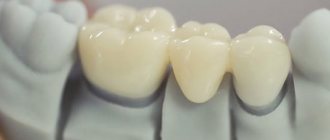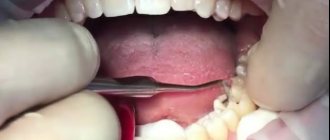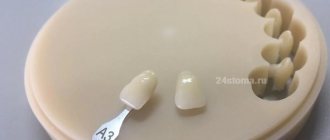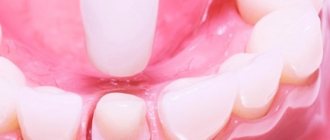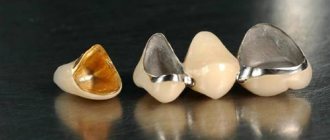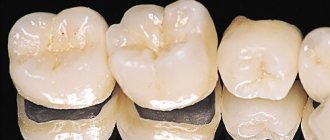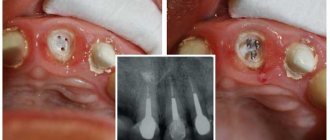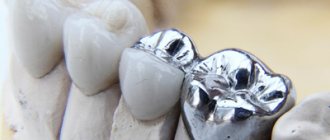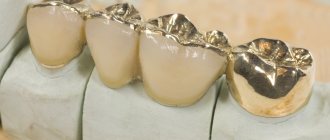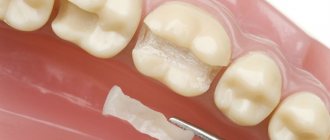Installing crowns is one of the most effective ways to restore teeth. How can you determine that the prosthesis is of adequate quality and that the fixation procedure was carried out according to all the rules? It’s very simple: artificial teeth should not be visually different from real teeth. By and large, such a result can only be achieved if two conditions are met: the doctor installing ceramic crowns must be a true professional, and the structure itself is made of solid ceramics. Andrey Nikolaevich Karneev, leading orthopedist at the German Implantology Center, spoke about what a ceramic crown on a tooth is.
Metal-plastic crowns
Such prostheses are called conditionally temporary crowns. A cost-effective prosthetics option that involves installing crowns with a metal base and a plastic coating. Traditionally, structures are made of nickel, cobalt, and chromium.
Despite the natural appearance and relatively good functionality, it is not worth wearing such prostheses for a long time: the product quickly loses its whiteness, slightly increases in size and needs to be replaced.
Among the undeniable advantages of metal plastic are its low cost and gentle effect on the enamel layer of the tooth. If the product is slightly deformed, it can be repaired directly in the patient’s mouth. Among the disadvantages of this choice, it is worth highlighting the low strength of the structure and the likelihood of developing allergies.
Metal-ceramic crowns
Practice shows that metal-ceramic crowns are deservedly considered the most popular. The base of the product is metal (cobalt, chromium, titanium, gold, etc.). To give the crown an aesthetic appearance, the metal base is covered with a ceramic layer and the elements are connected by exposure to high temperatures.
The popularity of metal ceramics in prosthetics is explained by its obvious advantages:
- Aesthetics. The material with which the crown frame is covered completely recreates the anatomical structure of the enamel;
- Sufficient strength. The products are quite durable due to the cast metal frame - they can withstand normal chewing loads and do not wear out. It is rare to see chipping of the enamel coating. In this case, repair of the prosthesis can be done in the patient’s mouth;
- Versatility. Crowns of this type are installed both on individual fragments of a row, and in the form of a dental bridge.
Since the ceramic layer is completely opaque, the prosthetic fragment (especially with a single restoration) can stand out against the background of natural teeth. Another disadvantage of metal-ceramic crowns is the need to grind the unit, after which it forever loses its original shape.
Metal crowns
These are the predecessors of all other types of dentures. This type of prosthesis is indicated for installation only on chewing teeth, since the structures are noticeable on the front teeth. Metal crowns are made of steel, titanium, platinum, and gold. Alloys containing cobalt, chromium, and silver are also in demand.
In laboratory conditions, stamped or cast products with spraying are prepared for patients. Standard structures take on the desired shape as work progresses. Individual production of the cap guarantees maximum adherence to the tissues, which eliminates rapid abrasion of the material and the spread of bacteria under the prosthesis.
Among the advantages of such products, it is worth noting their exceptional strength (due to the plasticity of the material, a crown made of this type of material does not crack and does not wear out for a long time). However, metal dentures are extremely unaesthetic, can cause allergies, and are difficult to fit on a tooth.
In addition, when using metal prosthetics, it is worth considering that crowns made from several types of metal cannot be used at once. If the patient already has a steel structure in his mouth, in the future he will have to fix crowns only from this material. Otherwise, the patient may develop galvanic syndrome, which is manifested by a burning sensation in the mouth and a “metallic” taste.
Metal-plastic crowns
Another name for this type of crowns is combined. The structural structure of the crowns is as follows: a cast metal alloy frame, which is additionally covered with a white plastic mass. The advantage of combined crowns is an affordable price, as well as acceptable aesthetics. The average cost of metal-plastic crowns starts from five thousand rubles.
However, combined crowns have a number of disadvantages that are definitely worth considering:
- The plastic finish of crowns very quickly loses its visual appeal; it may turn gray or yellow. Plastic tends to absorb moisture from the external environment and therefore the plastic layer swells and an unpleasant aroma begins to emanate from it;
- Combined crowns do not have high strength indicators; they can break due to excessive loads; most often, during the chewing process, it is the finishing plastic lining that falls off.
Plastic has fairly low biocompatibility rates, so metal-plastic crowns are not recommended for installation by people prone to allergic reactions.
Ceramic crowns for teeth
Metal-free crowns are deservedly recognized as the most aesthetic: they are extremely difficult to distinguish from natural teeth, even if the gum tissue becomes thinner, the prosthesis remains invisible and looks natural. In dentistry, several types of metal-free dental crowns are used:
- Porcelain or all-ceramic. They are made according to a personal impression from pressed material without adding other components.
- Mixed (zirconium dioxide and ceramics). They are stronger than the previous type of prosthesis, have high light transmittance and do not cause allergies.
- Mixed (aluminum oxide and ceramics). The designs are made of translucent hypoallergenic material, which is comfortable to wear and resistant to temperature changes.
All ceramic products are biologically compatible with mucous membranes and do not tend to cause allergic reactions. Other advantages of the designs include:
- light weight (a crown can be installed even on weakened teeth);
- immunity of ceramics to dyes;
- the need for minimal tooth grinding before ceramic prosthetics.
The disadvantages of this method of prosthetics include the relatively high cost of the products, as well as their fragility. Ceramic structures are not designed for significant chewing loads, which is why they are more often used for prosthetics of the upper incisors.
If you properly care for ceramic products, they will last from 10 to 15 years. At the same time, the prosthetic structure is not susceptible to caries and does not accumulate plaque.
In what cases is it better to install veneers?
Dentists recommend that patients with crooked or unsightly front teeth get veneers. They are very suitable for hiding gaps between teeth. After treatment of a tooth, many observe its darkening, possibly yellowing. Doctors attribute this effect to tissue death or a reaction to dental filling material. Of course, this is unsightly, especially if such a tooth is located in the smile area.
This problem can be easily corrected by applying a veneer. The color of the plate can be chosen so that it is similar to the shade of the entire dentition. Therefore, the selection and installation of veneers is individual in each case.
The method of installing veneers involves light preliminary treatment of the teeth - from 0.2 to 0.7 mm is removed, on which thin plates are subsequently placed. Veneers can be composite or ceramic; the dentist places them exclusively on the facial surface of the teeth. Their service life is from 10 to 15 years.
If you have dental problems described below, then you should contact a good dentist to install suitable veneers:
- interdental space or gap;
- uneven color of the enamel without the possibility of bleaching it (this includes spots, stripes and yellowness);
- unsatisfactory tooth shape or slight curvature, crowding of teeth;
- various defects, for example, cracks or chips;
- tooth decay less than 50%;
- lack of obvious flaws, but the desire to get a beautiful Hollywood smile.
Before deciding to install veneers, patients should learn that such plates are placed in the absence of serious defects and in the presence of all teeth in the front row. If there is a sufficient layer of enamel and the lingual side of the tooth is in order, installation of a veneer is possible, otherwise it is necessary to install a crown.
Veneers will not be installed if there is:
- abnormal bite development;
- pathological abrasion of teeth, thinned enamel;
- bruxism;
- a tooth on which there is a large filling or the main part of the dental tissue is destroyed;
- hobby related to extreme sports.
Considering the above, we can conclude that plates are an excellent solution for patients with healthy teeth.
Zirconium dioxide crowns
Zirconium crowns are prepared in laboratory conditions using high-precision computer equipment. Laser scanning allows for an accurate analysis of the dentition, after which a computer program models an accurate crown for the tooth. Optical data is transferred from the computer to a milling machine, which grinds the prosthesis from the workpiece.
These types of dental crowns are the most expensive. Their price is justified by a number of obvious advantages:
- Strength. Zirconium dioxide is as durable as natural tooth enamel. Even solid bridges can be made on the basis of this material;
- High aesthetics. The shade of zirconium dioxide can easily be matched to the color of the natural enamel layer;
- Biological compatibility. Zirconium dioxide is safe for human health. This type of prosthetics is not contraindicated for patients with metal allergies.
The products are recommended for installation by patients who have high demands on the appearance of structures and want their new teeth to be indistinguishable from natural elements.
Stamped crowns
In modern dentistry they are used extremely rarely, since they have few advantages, but a significant number of disadvantages. Stamped crowns are produced from a special type of blank - metal sleeves. Such a crown can be made with gold or silver plating.
As mentioned above, crowns using the stamping method were valued for their low price and the absence of the need to sharply grind the supporting teeth, but stamped crowns do not have an aesthetic appearance, quickly deform, and do not fit tightly to the neck of the tooth, which is why residues can get under the crown food, saliva and, naturally, pathogenic microflora. Caries under stamped crowns was not uncommon!
Gold crowns on teeth
Separately, it is worth noting the type of metal crowns - gold products. In dentistry, pure material is not used in the manufacture of dentures, since gold is a soft metal. Traditionally, an alloy with palladium and platinum is used. The structures fit well, do not irritate the mucous membrane, and do not lead to bleeding gums.
Very often, gold dentures are coated with a ceramic layer. Such products can even be placed on the front teeth: they retain the beneficial properties of the base material and look good.
What are the best crowns for front teeth?
When we are trying to figure out how to choose the best crowns for the front teeth, the priority criterion is the aesthetic component. At the same time, prosthetic structures intended for the frontal region must have a natural appearance, fully correspond to natural analogues and have sufficient strength. However, when you plan to fix a crown on the front teeth, there is no point in asking: “Which dentures are better to install on the lower jaw, and which ones on the opposite side?”
In both cases, the same type of prosthetic device models are used. Below we will provide more selected information:
- Metal-ceramic crowns . Despite the reasonable cost, this is not a completely suitable option in terms of aesthetic parameters. Firstly, an undesirable bluish tint appears in the area where the prosthesis adheres to the gum. Secondly, the metal base can be viewed through the ceramic coating. Of course, today there are improved designs with shoulder mass, but their price will significantly exceed the cost of a standard crown;
- Dentures made of ceramic material . This is the most advantageous option in cases where a dilemma arises as to which crowns are best placed in the frontal part of the jaw. Moreover, for this department you can resort to the help of traditional prostheses made of all-ceramic material. Their cost is considered affordable for most patients;
- Zirconium crowns . This solution is considered one of the most expensive when it is necessary to reproduce anterior teeth. However, this option is considered preferable for those who want to find out which crowns are best to put on their front teeth, but for whom pricing policy does not matter;
- Emax crowns . Such designs are made from an improved material - glass ceramics, which has excellent aesthetics. In this case, it is advisable to choose the E-max RPESS Multi material, which has a gradient of color and transparency, which will allow you to recreate the lost frontal units with maximum identity.
Temporary crowns on teeth
Since dental prosthetics requires time, the patient is often given temporary crowns. The patient wears the dentures until the permanent dentures are ready.
We are talking about inexpensive polymer, acrylic, and plastic crowns, which are designed to protect the prepared units from displacement and pathogens. In addition, they perfectly perform an aesthetic function, masking “holes” in the oral cavity.
Temporary crowns can be placed on natural teeth or on implants. Due to these structures, an even distribution of the chewing load is ensured, the risk of jawbone resorption is reduced, and the rate of adaptation to a permanent prosthesis is accelerated.
Factors in determining the price of prosthetic crowns
Even for crowns made from the same material, produced using the same technology, prices in different dentistry can vary greatly. This is explained by the fact that when determining the price of a crown, the following factors are taken into account: The pricing policy of a particular clinic. Different dentists focus on different consumer audiences. Therefore, prices may vary. For example, in some dentistry, the price of zirconium crowns will be 25,000 rubles, but you can also find offers with a lower cost - from fifteen thousand rubles; Experience, level of qualification of the doctor who will conduct orthopedic treatment; The work of a dental technician directly involved in the manufacture of crowns. The crown production technology can also be mentioned here; Cost of crown production material; Equipment of the medical facility. If the clinic does not have its own laboratory for the production of dentures and crowns, it will be forced to turn to the services of a third-party organization and, naturally, will include its costs in the price of the crown.
Equipment of the medical facility. If the clinic does not have its own laboratory for the production of dentures and crowns, it will be forced to turn to the services of a third-party organization and, naturally, will include its costs in the price of the crown.
Of course, any person faced with the need to get a crown wants to save on the service and at the same time receive high-quality treatment. It is possible to save on prosthetics with crowns, but the approach to saving must be competent. For example, you can install a combined bridge with crowns made of different materials or opt for metal crowns if we are talking about prosthetic teeth while talking and smiling that remain invisible to others.
But we categorically do not recommend you to chase low prices for dental crowns. Most often, the low price of crowns is not explained by a profitable promotion from the clinic, but by the low quality of materials and the work of inexperienced doctors and technicians. Such a crown will not last long, which means you will have new visits to the dentist and, accordingly, new expenses.
Would you like to receive detailed advice on crown prosthetics? Make an appointment with our dental specialists in Moscow - Vanstom!
Ranking of dental crowns by nomination
| The most | |
| Aesthetic | Unaesthetic |
| Zirconium | Metal |
| Durable | Short-lived |
| Zirconium/Metal | Metal-plastic |
| Biologically compatible | Unsafe for the body |
| Zirconium/Ceramic/Metal-ceramic with gold-platinum alloy frame | Nickel-based metal-ceramic |
What dentures are best for the front teeth?
Since the teeth in the smile area are visible to others, high aesthetic demands are placed on prosthetics in this area. In this regard, it is better to install prostheses made of zirconium dioxide (aluminum oxide), metal ceramics or all-ceramic crowns on the front teeth.
Caps made of solid ceramics are put on the upper incisors; they look good and are not subject to heavy loads. Products are made from medical porcelain using injection molding.
The lower incisors and canines bear a significant load, so in this case, solid ceramics are replaced with zirconium dioxide. The durable frame is coated with a ceramic layer to create a reliable and attractive prosthesis for the front teeth.
In addition, zirconium dioxide is successfully used when installing dental bridges in the smile area.
Attending doctors at the Elident clinic
Mlodik Boris Naumovich
Dental surgeon, implantologist, orthopedist
Clinical experience : 26 years
Vakhrushev Alexander Viktorovich
Dental surgeon, implantologist, orthopedist
Clinical experience : 25 years
Metal-ceramic crowns for front teeth
The basis for this design is a metal base with a thickness of 0.5 millimeters. To obtain the material for such prostheses, a combination of chromium and cobalt is used, but sometimes you can find products made from precious alloys. In laboratory conditions, to create such crowns, they resort to the method of layer-by-layer application of ceramic material onto a metal frame. To ensure maximum strength and solidity of the structure, the ceramic mass is fired under high temperature conditions.
An aesthetic disadvantage of the above orthopedic products is the presence of a metal base under the ceramic layer. Moreover, the porcelain material used must be opaque to eliminate the possibility of it showing through the metal.
However, the light transmittance of dentin and enamel should be taken into account, which makes the outermost part of the tooth transparent in bright light. This indicates the inadmissibility of installing metal-ceramic structures for people with increased enamel transparency. The best option for using such crowns would be for patients with low levels of transparency. But it must be borne in mind that in strong lighting, differences in shade and light transmission may still be visible.
So, crowns for the front teeth made of metal-ceramics, as evidenced by reviews, have the following positive characteristics:
- Acceptable aesthetic indicators;
- Affordable price;
- High structural strength.
The disadvantages of such structures include:
- Negative effects on natural teeth;
- The likelihood of allergic reactions to metal material;
- Risk of cyanosis near the gingival margin.
Metal-ceramic crown »
Ceramic crowns for front teeth
These metal-free crowns for the front teeth are considered indispensable when restoring teeth in the frontal area. They allow you to eliminate some of the aesthetic shortcomings of natural enamel, which include excessive abrasion, developmental pathologies and massive surface damage. In addition, all-ceramic designs are ideal for individuals with a high likelihood of allergic reactions to metal alloys. However, they are not installed in the area of chewing teeth, due to their increased fragility.
The ideal option is to fix such crowns within 1-2 lost units. Bridge crowns made of this material are not installed on the front teeth.
However, today, due to the active use of innovative technologies, you can find dentures made of ultra-strong ceramic material, suitable for recreating any lost tooth. Unfortunately, the cost of such a design will exceed the prices for classic products made from solid ceramics.
So, the “advantages” of the products presented above include:
- Impeccable aesthetic indicators;
- Full compatibility with the human body;
- Absolute identity with natural analogues.
Among the disadvantages of metal-free structures are:
- Insufficient strength;
- Overpriced.
Ceramic crowns for teeth »
Zirconium crowns for front teeth
Zirconium crowns for the front teeth are among the most durable and aesthetically perfect modern designs. Due to the use of zirconium material in their manufacture, it is possible to achieve high reliability indicators characteristic of metal and obtain prostheses with good hypoallergenic qualities.
Ceramic crowns for the front teeth, made on the basis of this material, do not have a metal base, which provides excellent aesthetic parameters. But their main advantage is still increased strength.
It should be noted that, despite the positive characteristics presented, some patients express dissatisfaction with the installed zirconium crowns. This is due, first of all, to the rather low light transmittance. That is, the difference between the transparency of natural enamel and the prosthesis material can also be traced here.
This means that it is better to install these designs in patients with slight transparency of natural enamel, which will provide a completely harmonious aesthetic effect.
However, at the present stage of development of dentistry, there is an improvement in the properties of zirconium crowns. Many manufacturers have taken a course towards creating blocks with higher levels of transparency and pre-painted products with a gradient. This made it possible to develop orthopedic structures that are completely identical to natural teeth.
Thus, zirconium dioxide prostheses are famous for the following advantages:
- Acceptable aesthetics;
- Increased reliability indicators.
The disadvantages of such products include:
- Lack of transparency corresponding to natural enamel;
- Zirconium crowns for front teeth are overpriced.
Zirconium crowns »
Ceramics on a zirconium frame
If you are interested in the question: “Which crowns are best to put on the upper front teeth?”, this option is certainly a winner. Such prostheses are ideal for those patients who dream of ultra-strong structures with excellent aesthetic parameters.
Unlike metal-ceramic prostheses with low aesthetic properties, zirconium-based crowns combine high aesthetic properties and the necessary strength.
Such crowns for the front teeth made of zirconium, as confirmed by reviews, are used not only in the process of single prosthetics, but are also excellent for the manufacture of bridge structures. At the same time, increased strength is achieved through the use of computerized technologies and milling methods.
So, some of the positive aspects when using these products include:
- Ideal aesthetics;
- Excellent reliability indicators.
Negative sides:
- Overcharge.
What is better to put on chewing teeth?
Since the chewing teeth bear the bulk of the load, the crowns on them must be strong. Most often, metal-ceramic crowns are placed in the lateral sections. Metal ceramics are durable and aesthetic, but require significant grinding of dental tissue.
Zirconium dioxide has proven itself to be excellent. Its strength is comparable to the strength of metal crowns; only zirconium prostheses, unlike metal ones, are very similar to natural teeth. Another advantage of this choice is the insignificant grinding of tooth enamel before prosthetics.
All-metal crowns on teeth are cheaper. They have a long service life and are resistant to corrosion. An even more significant disadvantage of such prostheses (in addition to the low level of aesthetics) is the risk of developing an allergy to the material.
Caring for tooth crowns
When studying the topic of dental crowns and trying to understand which ones are better, many rely on reviews from other patients and specialists. At the same time, any qualified doctor will tell you that to extend the life of a prosthetic device, you first need to pay attention to the rules of care.
For example, if you have a single crown installed, it is enough to carry out regular hygiene procedures using toothpaste, brush and dental floss. In the presence of bridge structures, as well as in patients with periodontal pockets in the area of dentures, it is necessary to resort to the help of irrigators. These devices help clean hard-to-reach areas from dental plaque and food debris.
Article expert (author):
Duration of operation of different types of crowns
The most short-lived structures are made of metal-plastic. Therefore, they are traditionally used as temporary crowns. The maximum service life of products is 5 years. According to patient reviews, over time the plastic coating deforms and darkens.
Metal-ceramics is a practical option that is installed on both the front and chewing teeth. Such structures last up to 10 years.
Crowns made of medical porcelain do not darken or fade and can last up to 10-15 years. Throughout this period, the product looks like a natural tooth.
Crowns made of zirconium dioxide are considered even more stable: their service life is 15-20 years.
Prostheses made from precious metal alloys and products made from nickel are also durable and can last up to 15 years.
The service life of different types of crowns depends not only on the material, but also on the accuracy of installation. There should be no voids or gaps under a well-fixed crown. Otherwise, food debris will accumulate under the product, which over time will lead to the development of an inflammatory prosthesis.
Zirconium crowns
An innovative CAD/CAM manufacturing technique is used to produce zirconium dioxide crowns. It allows the production of orthopedic structures with minimal human intervention. Crowns are turned using milling equipment, and their layout is made using special computer technologies.
Zirconium is a unique material; it not only has optimal biocompatibility with the human body, but also high strength, comparable to the strength of metal. The cost of zirconium crowns starts from 16 thousand rubles.
Two types of zirconium crowns can be used for restoration and prosthetics:
- Two-layer, that is, consisting of a zirconium frame, which is subsequently covered with ceramic mass. The use of this type of crown allows you to obtain the most aesthetic result of restoration, but there is also a minus - if used incorrectly, the ceramics from the frame may chip and the prosthesis will have to be restored;
- Monolithic crowns are machined from solid zirconium blocks and do not have a porcelain outer layer, but in terms of aesthetics they will be significantly inferior to the first type of product.
If prosthetics are performed in the area of the front teeth, where aesthetics are important, glass-ceramic crowns may be the best choice.
How to properly care for crowns
The method of caring for crowns is practically no different from the principles of caring for natural teeth and involves:
- performing oral hygiene twice a day (not only the teeth, but also the tongue should be brushed);
- cleaning the spaces between teeth and the space under dentures. To ensure the proper level of hygiene, it is preferable to use an irrigator: a directed jet helps to quickly and painlessly clean the space under the product;
- nutrition correction - excluding too hard foods and temperature changes from the menu;
- monitoring the condition of the gums and areas where teeth meet crowns (this is where caries most often develops);
- using mouth rinses after each meal (special formulations can be replaced with plain water).
Dentists also advise periodically massaging the gums under the structure. Soft tissues undergo increased pressure, so it is important to stimulate blood circulation in these areas. The gums should be massaged with smooth circular movements clockwise and counterclockwise.
How much does it cost to install a crown on a tooth?
The key criterion that determines the cost of prosthetics is the material used to make the prosthesis. If you arrange them from cheapest to most expensive, the list will look like this:
- metal-plastic;
- metal;
- gold;
- metal ceramics with ordinary metals;
- metal ceramics on a gold base;
- ceramics;
- zirconium dioxide.
In addition to the material, the price of the prosthesis is also influenced by the pricing policy of the clinic, the equipment used, and the qualifications of the attending physician. Some clinics manage to save money on prosthetics by installing crowns on several teeth at once.
It is impossible to accurately answer the question of which crown is best to install. The doctor makes the decision together with the patient. When choosing, emphasis is placed on clinical indications, characteristics of the patient’s jaw system, the state of oral health in general, the wishes and financial capabilities of the person.
Combined dental bridges with crowns made of different materials
Bridges for crowns made of metal-ceramics and crowns made of metal are made on the same base - on a frame cast from a metal alloy, and therefore crowns from different materials can be combined on a bridge of this type. For example, crowns that fall into the smile zone can be made from more aesthetic metal-ceramics, while crowns that are invisible to others can be made from metal.
The work on manufacturing a combined bridge will not be highly complex, but the overall cost of prosthetics with crowns will decrease, which is not always adequately perceived by doctors seeking to make money on their patients. If you are assured that a combined bridge with crowns cannot be made in your case, you are being deceived and it probably makes sense to go to another dentistry, where the patient’s wishes are perceived and taken into account.
Alternatives to a Dental Crown
Veneers are often preferred to crowns in the smile area. However, in this case, the back side of the elements should be more or less preserved.
Teeth can be restored using filling materials. This method can only be used if the destruction of the unit is not so global (less than half).
Judging by the reviews of doctors and patients, crowns are considered the optimal solution for significant damage to teeth, since they not only restore the functionality and aesthetics of a row, but also protect teeth from further destruction. An additional bonus of this type of prosthetics is the variability of materials and, accordingly, the cost of services.
Cast crowns
The main material for the production of cast crowns is an inexpensive alloy of cobalt and chromium; their surface looks perfectly smooth and even, like well-processed and polished metal. If desired, you can do a finishing gold plating. Cast crowns have good durability and wear resistance, a budget price, but extremely low aesthetics. The average cost of a cast crown is five thousand rubles.
Cast crown products are a good option for prosthetics in the area of chewing teeth; they do not require significant grinding of the teeth that support the fixation of the prosthesis. If such crowns are placed in the smile area, they can be additionally lined with special plastic overlays to achieve greater aesthetics.
